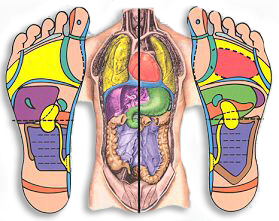Reflexology
Enhancing Well-being Naturally
 Reflexology is an ancient therapy that involves applying pressure to specific points on the hands, feet, and ears to promote healing and relaxation throughout the body. Developed by William H. Fitzgerald and Eunice Ingham in the early 20th century, reflexology is based on the principle that these points correspond to different organs and systems in the body.
Reflexology is an ancient therapy that involves applying pressure to specific points on the hands, feet, and ears to promote healing and relaxation throughout the body. Developed by William H. Fitzgerald and Eunice Ingham in the early 20th century, reflexology is based on the principle that these points correspond to different organs and systems in the body.
During a reflexology session, a practitioner uses thumb-walking, finger-walking, and rotating movements to stimulate these points gently. The benefits of reflexology include stress relief, pain management, improved circulation, enhanced energy levels, and overall support for health.
In recent years, reflexology has gained popularity as a non-invasive, holistic approach to wellness. It is offered in spas, wellness centers, and healthcare facilities, appealing to those seeking natural ways to relax, reduce stress, and support their health. Reflexology offers a natural and effective solution for enhancing one’s health and vitality, making it a valuable tool in promoting overall well-being.
Sessions Include
Elements of a reflexology treatment session include:
- Consultation: Gather information about the client’s health history and treatment goals.
- Relaxing Environment: Create a peaceful setting with soft lighting and soothing music.
- Examination: Check for sensitive areas on the hands, feet, or ears.
- Pressure Application: Apply pressure to specific reflex points using various techniques.
- Gentle Massage: Incorporate gentle massage to relax muscles and improve circulation.
- Relaxation and Healing: Promote relaxation, reduce stress, and restore balance.
- Post-Treatment Recommendations: Provide self-care advice to maximize the benefits at home.
These elements work together to offer a holistic and rejuvenating experience during a reflexology session.
CONTACT US »

